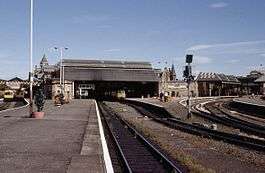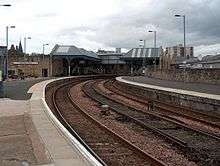Perth railway station (Scotland)
Perth railway station is a railway station located in the city of Perth, Scotland. The station, designed by Sir William Tite, won an architecture prize. It has seven platforms, four of which are "through" platforms.
| Perth | |
|---|---|
| Scottish Gaelic: Peairt[1] | |
 Perth station in 1989, seen from the south with the Dundee platforms to the right | |
| Location | |
| Place | Perth |
| Local authority | Perth and Kinross |
| Coordinates | 56.3916°N 3.4384°W |
| Grid reference | NO112231 |
| Operations | |
| Station code | PTH |
| Managed by | Abellio ScotRail |
| Number of platforms | 7 |
| Live arrivals/departures, station information and onward connections from National Rail Enquiries | |
| Annual rail passenger usage* | |
| 2014/15 | |
| – Interchange | 0.119 million |
| 2015/16 | |
| – Interchange | |
| 2016/17 | |
| – Interchange | |
| 2017/18 | |
| – Interchange | |
| 2018/19 | |
| – Interchange | |
| History | |
| Original company | Scottish Central Railway and Scottish Midland Junction Railway |
| Pre-grouping | Caledonian Railway |
| Post-grouping | LMS |
| 22 May 1848 | Opened as Perth General[2] |
| 1952 | Renamed as Perth[2] |
| Listed status | |
| Listing grade | Category |
| Entry number | LB39340[3] |
| Added to list | 26 August 1977 |
| National Rail – UK railway stations | |
| * Annual estimated passenger usage based on sales of tickets in stated financial year(s) which end or originate at Perth from Office of Rail and Road statistics. Methodology may vary year on year. | |
There are two entrances, both of which allow car parking. The ticket office, newsagent and café are between Platforms 2 and 3. The original main concourse was between the current Platforms 4 and 7, and the station was covered by a large overall roof, which still exists in a reduced form. There used to be nine platforms. Ticket barriers are in operation.
History
Openings
The station was opened (as Perth General) by the Scottish Central Railway in 1848. Originally the terminus of the SCR main line from Greenhill Junction near Glasgow, it soon became a junction of some importance with the arrival of the Dundee and Perth Railway from Dundee (following the completion of a bridge across the River Tay), the Edinburgh and Northern Railway from Ladybank on the Fife coast and the Scottish Midland Junction Railway from Forfar within months.[4] Subsequent construction by the Perth and Dunkeld Railway and the Perth, Almond Valley and Methven Railway added further lines into/out of the city, with the former becoming part of what is now the Highland Main Line to Inverness. The SMJR meanwhile would become part of a through route to Aberdeen by 1856, thus giving Perth travellers easy access to all of the major Scottish cities.
All of these lines, apart from the E&NR would eventually be taken over by the Caledonian Railway, though the Highland Railway (which took over the P&DR) and North British Railway (which absorbed the E&NR) also had access by means of running powers from Stanley Junction and Hilton Junction respectively.
The NBR would subsequently open a more direct route to the Scottish capital than the Caledonian's route via Stirling and the central lowlands in 1890 - this left the existing Ladybank line at Bridge of Earn and headed south via Glenfarg to Mawcarse, where it joined the Fife and Kinross Railway's line to Kinross.[5] Trains could then travel via Cowdenbeath, Dunfermline and the newly opened Forth Rail Bridge to reach Edinburgh.
Closures
The Almond Valley line to Crieff & Methven was an early post-nationalisation casualty, closing to passengers in October 1951. The Ladybank service followed suit in September 1955.[6] The major losses though came as the result of the Beeching Axe and its aftermath in the mid-to-late 1960s, with the ex-SMJR main line to Kinnaber Junction via Coupar Angus and Forfar being closed to passenger traffic on 4 September 1967; Aberdeen services were thereafter routed via Dundee and the former NBR route via Montrose. The Aviemore to Forres section of the Highland Main Line had already been closed two years earlier, and several local stations in the area were also shut down around this time.
A further significant (and controversial) closure came on 5 January 1970, when the Glenfarg line to Kinross and Cowdenbeath was abandoned in favour of the older but less direct line via Stirling.[5] This route had been recommended for retention and development in the Beeching Report, but its removal allowed the planned M90 motorway to occupy its former alignment in the Glenfarg area when it was built a few years later. The additional time penalty associated with the rerouting proved unpopular with Edinburgh travellers though and so in 1975, the old E&NR line to Ladybank was reopened by British Rail to provide a slightly quicker alternative. This is the route followed by most Edinburgh services today, but the daytime and overnight trains to London (see below) still run via Stirling and Falkirk as the line via Ladybank and Kirckaldy is served by the Aberdeen to London services.
Layout

As mentioned above, the station has seven active platforms, but they are split into two distinct sections. Platforms 1 and 2 sit on the eastern side (the old Dundee & Perth Railway part of the station) and are the busiest in the station due to them handling the Glasgow to Dundee and Aberdeen trains. These platforms are 20 miles 64 chains (33.5 km) from Dundee; platform 1 can accommodate trains having eleven coaches, but platform 2 on the down (northbound) line can only hold nine.[7] The two platform lines then become single further east to cross the bridge spanning the Tay.
The remainder of the platforms (3–7) sit under the main train shed, the former HR/SMJR platforms once used by the Coupar Angus main line as well as services to the Highlands. This part of the station is 151 miles 25 chains (243.5 km) from Carlisle (measured via the former Ravenscraig No. 1).[7] Platforms 4–7 are an island in the shape of the letter H, with two long platforms along each side (the present platforms 4 and 7), which can hold 23 and 21 coaches respectively. Platforms 5 and 6 are the bays at the southern end of the island, they can hold ten and eight coaches respectively; originally, there were also two bay platforms at the northern end which are no longer used, but part of the track is now a siding for fuelling trains. These disused bay platforms, which are 151 miles 36 chains (243.7 km) from Carlisle, are the zero point for the Highland Main Line,[7] although mileposts do not change until Stanley Junction (158 mi 38 chains, 255.0 km from Carlisle and 7 mi 2 chains, 11.3 km from Perth).[8] Platform 3 is not part of this island, but is opposite platform 4 and adjoins platform 2; it is long enough for six-coach trains.[7] Platforms 3–7 now are used only by terminating trains from the Edinburgh direction and around a dozen trains per day each way on the Highland Main Line.
There was once an extensive goods yard here, along with an engine shed and carriage sidings but only a small engineers depot remains in the greatly downsized yard.
Services
Passenger services are operated by Abellio ScotRail, Caledonian Sleeper, and London North Eastern Railway, and the station is staffed throughout its opening hours.
There are two main routes passing through the station - the Glasgow to Dundee & Aberdeen Line and the Highland Main Line, whilst there is now also a regular service to/from Edinburgh via the Fife Coast. Services to both Glasgow Queen Street and Edinburgh Waverley depart hourly (with some extras to Glasgow), as do those to Aberdeen via Dundee, Carnoustie and Arbroath. Trains to Inverness are somewhat irregular, but run at least once every two hours with eleven departures in all on weekdays & Saturdays and seven on Sundays.[9]
The daily (overnight) Caledonian Sleeper service between Inverness and London Euston and the daily London North Eastern Railway Highland Chieftain service between Inverness and London King's Cross call at this station.[10]
In March 2016, Transport Scotland announced a package of timetable improvements for the Scottish rail network that will see additional trains operated from Perth to Glasgow, Edinburgh, Dundee & Inverness from 2018. There will be a two-hourly service between both Edinburgh & Glasgow and Inverness over the Highland Main Line (combining to give an hourly frequency north of Perth) and additional regional services from Arbroath & Dundee to Glasgow serving Gleneagles, Dunblane & Stirling on top of the current Aberdeen to Glasgow route (which will be accelerated by cutting some of the existing intermediate stops).[11]
In popular culture
The movie The Railway Man was filmed at Perth station, which was used on Platform 3 to pose as Crewe, and Platform 5 used to pose as Edinburgh, both set during the 1960s.
Perth station was nominated the Carbuncle Award in 2015, which recognizes the worst planning decision. The award was due to the fact a new footbridge had to be built at the southern end of the station which has stair and lift access to all platforms to comply with disability laws. Local newspaper The Courier reported on the news and interviewed Paul Tetlaw from the campaign Transform Scotland. He said:
"It's an off-the-shelf structure that has desecrated the station environment, imposed from London by 'standards bound' Network Rail designers and has no fit with the largely Victorian surroundings. To add insult to injury, it's virtually unused, as the alternatives within the station building are vastly more convenient for the overwhelming majority of passengers. This tacky and inappropriate new structure is thought to have cost in excess of £1m — money which would have been better spent on opening a new station in nearby Newburgh, which has none, with cash left over for a feasibility study of recreating a direct Perth-Edinburgh link, as advocated by our inter-city express campaign."
Railway connections
References
Notes
- Brailsford 2017, Gaelic/English Station Index.
- Butt (1995), page 184
- "LEONARD STREET, PERTH RAILWAY STATION INCLUDING CARRIAGE SHED AND GATEPIERS". Historic Scotland. Retrieved 9 March 2019.
- Railscot - Scottish Midland Junction Railway Railscot; Retrieved 2014-01-31
- Railscot - Glenfarg Line
- Railscot Chronology - Edinburgh & Northern Railway
- Brailsford 2017, map 15D.
- Brailsford 2017, map 19A.
- GB National Rail Timetable 2015-16, Table 229 (Network Rail)
- GB National Rail Timetable 2015-16, Tables 402 & 26 (Network Rail)
- "Scotrail rail revolution declared as 39 carriages ‘to be retained by ScotRail’ instead of going elsewhere"Rail.co.uk news article 25 March 2016; Retrieved 18 August 2016
Sources
- Awdry, Christopher (1990). Encyclopaedia of British Railway Companies. Sparkford: Patrick Stephens Ltd. ISBN 1-8526-0049-7. OCLC 19514063. CN 8983.
- Brailsford, Martyn, ed. (December 2017) [1987]. Railway Track Diagrams 1: Scotland & Isle of Man (6th ed.). Frome: Trackmaps. ISBN 978-0-9549866-9-8.CS1 maint: ref=harv (link)
- Butt, R. V. J. (1995). The Directory of Railway Stations: details every public and private passenger station, halt, platform and stopping place, past and present (1st ed.). Sparkford: Patrick Stephens Ltd. ISBN 978-1-85260-508-7. OCLC 60251199.
- Jowett, Alan (March 1989). Jowett's Railway Atlas of Great Britain and Ireland: From Pre-Grouping to the Present Day (1st ed.). Sparkford: Patrick Stephens Ltd. ISBN 978-1-85260-086-0. OCLC 22311137.
External links
- Winchester, Clarence, ed. (2 August 1935), "Perth General Station", Railway Wonders of the World, pp. 839–844, description of the station in the 1930s
| Wikimedia Commons has media related to Perth railway station, Scotland. |